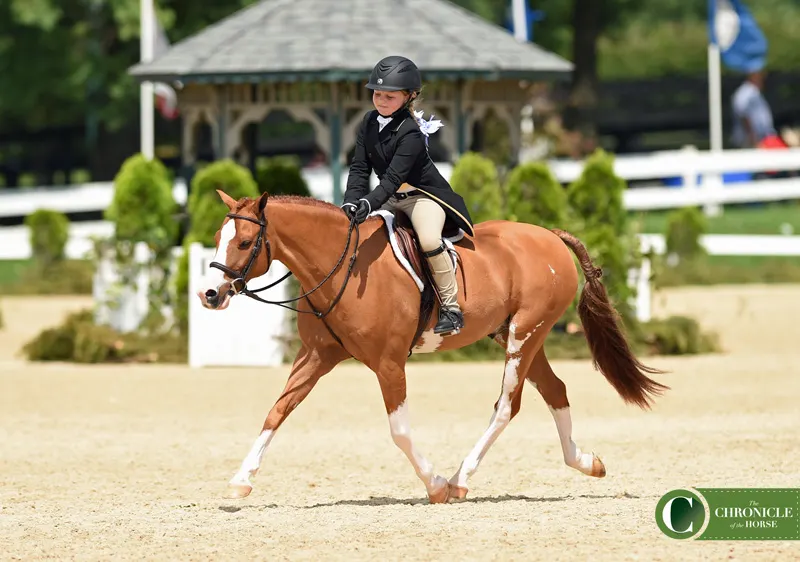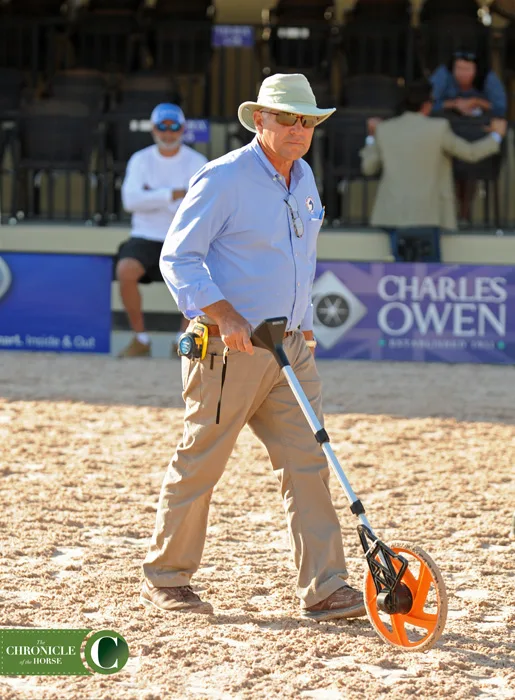Forty rule change proposals—26 fewer than last year—will be considered at the upcoming U.S. Hunter Jumper Association Annual Meeting, which takes place online from Nov. 30 to Dec. 11. Members have until Nov. 30 to submit comments on the rules.
Rule change proposals that are approved by the USHJA board of directors at the meeting will go forward to the U.S. Equestrian Federation, and ultimately the USEF board of directors will vote to add them to the “USEF Rulebook.”
Sport Conversations

A rule change proposal suggests allowing hunter exhibitors to demonstrate their horse’s soundness by trotting on a loose rein in a circle following their round. Kimberly Loushin Photo
A rule change would make permanent the method by which hunters have been tested for soundness throughout the COVID-19 pandemic, namely by allowing hunters to trot a circle on a loose rein at the end of the over fences performance rather than jogging in hand following the class. Shows that specifically state it in the prize list will still be able to jog in hand for soundness after the performance portion of the class is complete.
A rule change would significantly tweak the standard equitation tests listed in the “Rulebook.” Dismounting and mounting would be removed; trot jumps are clarified to be 6″ lower than the class height, and trotting oxers reserved for classes at 3’6” or higher; turn-on-the-forehand is only to be performed from the halt. There’s also a new entry explaining that the following basic dressage movements from collected trot may be required: shoulder-in, shoulder-out, haunches-in (travers), haunches-out (renvers), leg-yield or half-pass.
Two rule changes would allow mules to compete in jumper classes.
A rule change proposal eliminates Table A/B classes.
A rule change would ensure that points earned at WCHR Challenge classes at Capital Challenge and the WCHR Spectacular classes will automatically count for USEF Horse of the Year credit in divisions. In the past USHJA had to be given special dispensation for points from the Spectacular to count, and points earned in WCHR Challenge classes did not count.
About Amateurs
A rule change proposal eliminates the amateur-owner jumper division at shows and adds in a separate year-end award from a ranking of amateur jumpers that were ridden by the recorded owner, in addition to the year-end award given to amateur jumpers. According to the stated intent, this would give all amateurs an equal opportunity to compete, while honoring amateurs who do own their own horses with a year-end award.

A rule change proposal suggests a three-way split in the amateur-owner hunter division. Mollie Bailey Photo
A rule change proposal creates a three way split in amateur-owner hunter divisions: 18-25, 26-41 and 42 and over. In the event that the amateur-owner division ran with a two-way split, management can use a floating split to determine the age breakdown or can split the division at 18-41 and 42 and over. The rule change proposal suggests USEF Horse Of The Year awards in two categories: 18-41 and 42 and over.
ADVERTISEMENT
At The Horse Show
A rule change proposal allows managers to change the table in a jumper class with less than $25,000 of prize money due to unforeseen circumstances like impending inclement weather, excessive entries or possible loss of daylight, provided competitors are notified at least two hours in advance. Any entered competitor not wishing to compete under the new table must be given a full refund.
A series of rule change proposals would prohibit earphones and earbuds while schooling and longeing.

A rule change would prohibit more than three hunter over fences classes per section in one day. Mollie Bailey Photo
A rule change proposal gets rid of a minimum time allowed of 325 meters per minute for pony, children and adult competitors. Their minimum time allowed is now 350 meters per minute. The rule intent states: “The 325 m/m was originally written for ponies. We added adults and children as they are the less experienced riders and we felt it might help them. Unfortunately no course designers measure their courses at 325 m/m, in fact most don’t realize the rules even exists. More to the point, adults and children never ride at 325 m/m, and the pony riders usually ride closer to 400 m/m, with their trainers yelling from the in-gate; ‘Faster, faster.’ The rule is pointless.”
A proposed rule change addresses combining jumper classes of different heights. The rule change gives an option that either the entry fee and prize money follow the class with the higher prize money or that both heights follow the original prize money, entry fee and payouts for each placing according to the prize list. As it stands now, there is no option for each height to follow what’s printed in the prize list.
On Officials
A rule change proposal clarifies the penalty in jumper classes in three specific instances: Competitors incur 4 faults for knockdown of timing equipment or other designated markers on start and finish lines provided they are part of the round being jumped; any competitor jumping out of the arena before, during or after their round is eliminated; and any competitor leaving the arena through the in/out-gate before beginning their round, voluntarily or involuntarily, whether or not tone to begin has sounded, incurs no penalty.
A rule change proposal removes the exemption that allowed hunter breeding judges more than two guest cards in their lifetime. The intent states that “R” hunter judges also receive education in hunter breeding as part of their licensure and renewal process and therefore are qualified to judge hunter breeding classes, so no guest cards are required. The licensed official education structure will include a certification designation for licensed officials who have received additional training in hunter breeding so that they may be recognized for their advanced training in the division.
A rule change proposal clarifies that a certified schooling supervisor’s decisions regarding schooling rules in the schooling/warm-up area are final; that person does not have to consult with the senior steward to make it official. It also states that any decision made by an unlicensed schooling supervisor, after consultation with the senior steward, regarding schooling rules in the warm-up/schooling area is final.
ADVERTISEMENT
A rule change proposal requires course designers to include the height and spread of each obstacle for classes restricted to 5-, 6- and 7-year-olds. The proposal also eliminates the need for a certificate of compliance in age-restricted jumper classes as, according to the rule’s stated intent, submitting course diagrams after the show doesn’t help competitors at the show.

A rule change proposal requires that course designers use a measuring wheel for jumper classes offering $25,000 or more of prize money. Mollie Bailey Photo
A rule change proposal clarifies the language describing the duties of hunter and jumper course designers and who is responsible for specific types of classes. The proposal aligns language among the equitation, hunter and jumper chapters.
Procedural
A rule change proposal addresses the mileage exemption process. The proposal defines the role of the USEF CEO related to the mileage exemption process, defines how the affiliate representative is selected for mileage exemption panels; creates a new randomized process for the formation of the mileage exemption panels, institutes training for all mileage panelists, specifies that both the internal review panel and the mileage exemption panel will be given the same documentation to aid in the review of a mileage exemption request, and creates a process for writing and publishing a majority and minority opinion after the mileage review process is finished.
A rule change proposal allows the steward and show management to make an exception to the rule that requires horses in jumper classes offering $25,000 or more in prize money to be on the show grounds at least 24 hours ahead of the class. The stated intent is: “Occasionally, there are exceptional circumstances preventing someone from being on the grounds exactly 24 hours prior to the class and this allows a certain amount of leeway.”
A series of rule change proposals would allow breeders to “register” their horses with the USEF as an alternate way to address the necessity for age verification in sections that restrict classes by age. Breeders must apply for USEF recording prior to Dec. 1 of the year of foaling accompanied by a notarized certificate signed by an AVMA-licensed veterinarian stating date of last cover, date of foaling, attendance to foal within 24 hours of birth, brief description of foal and name of sire and dam.
Chronicle staff will attend the USHJA Annual Meeting virtually this year and will report on the rule change discussions and all the other action.














